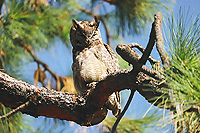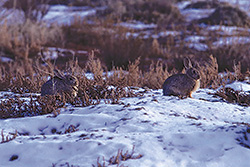December is a great month to explore the nightscape in Canyon Country. Darkness descends early in the evening and lasts until early morning, so you don’t have to stay up late to explore the night.
Dark skies, illuminated by brilliant stars and distant galaxies, provide a perfect backdrop and sideshow for staying out. Though these starry nights are exceptional, it’s the deep booming hoots of nocturnal great horned owls that make this time of year attractive to explore the night.
Preparation helps, so dress for the cold and pick a night with no wind for better listening conditions. Though these denizens of the dark may be found in town, hooting from their perches, take a drive up into Arches National Park or down the road towards Potash to listen for the classic call: hoo-h’HOO-hoo-hoo. The hoot’s appropriate mnemonic is Who’s Awake? me too too.
Patience is a virtue when owling. Standing quietly for five minutes may seem like a long time but this will give your ears a chance to adjust to the sounds of the night. These owls are early-season nesters, so they start calling in winter.
Great horned owls may hoot any time of the day, but they are more active at night. Their calls are to attract or communicate with their mate or to defend a territory that is invisible to us. Though the male is smaller than the female, his call has a lower pitch to it than the female’s call. When great horned owl pairs engage in a duet, it’s easier to hear the differences in pitch, and on a calm night, the hollow notes can carry for quite a distance.
 Nicknamed “Flying Tigers,” great horned owls prey on just about anything they can carry, including small mammals, skunks, birds, small foxes, rodents, scorpions, and even other owls such as barred or long-eared owls. And forget naming any barnyard or outdoor cats in great horned owl territories, too.
Nicknamed “Flying Tigers,” great horned owls prey on just about anything they can carry, including small mammals, skunks, birds, small foxes, rodents, scorpions, and even other owls such as barred or long-eared owls. And forget naming any barnyard or outdoor cats in great horned owl territories, too.
Finding a roosting owl in the daylight might be a bit of a challenge, as the birds use their cryptic coloration and body posture to blend into a tree’s trunk or branches. Even their large ear tufts (what gives these birds their name) may stand erect helping the bird to blend into their surroundings. The bird also uses natural cavities in canyon walls as roosting and nesting spots, so don’t forget to scan a canyon wall for these sites.
Great horned owls are not restricted to the Canyonlands region but occur all across North America and into South America. They are the most widely distributed of all owls and the most common. Unlike flammulated or burrowing owls, great horns do not migrate but they have been known to move short distances to wintering grounds in the far north.
A good source for practice listening to owl calls is the eBird website (www.ebird.org) or the National Audubon Society’s Bird Guide App (www.audubon.org). You can even make your own recording by using the Cornell Lab of Ornithology’s Merlin App (www.allaboutbirds.org) to record calls and use its artificial intelligence to identify the species.
Owling is a different way to experience the desert. Hopefully, you’ll hear a great horned owl or some other owl call during your winter nocturnal outing. Even if it’s quiet, the brilliant night sky is a great consolation and well worth the effort.